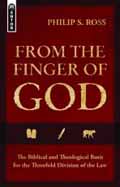
From the beginning of the Christian era, the church has divided biblical law into moral, civil and ceremonial categories. The Ten Commandments summed up ever-binding moral law, civil laws governing everyday life were only binding in ancient Israel, while Christ has fulfilled the ceremonial laws regulating worship. The primary practical-theological implication of this threefold division is that the Ten Commandments always bind everyone. To most Christians that may seem an uncontroversial assertion, but in the latter half of the twentieth century many scholars have dismissed this approach to the law as a dogmatic imposition on Scripture. This also raises questions about other Christian doctrines, particularly for those who want to uphold historic confessional statements concerning matters such as sin and atonement. If sin is not transgression of the law, then what is it? Does it make sense to maintain the idea of penal substitution while dismissing the idea of distinct and perpetual moral law?
This book investigates criticisms of the 'orthodox' and catholic approach to biblical law and concludes that theologians were not mistaken in their belief that the threefold division was rooted in Scripture. Christian teachers who viewed the Bible as a coherent, progressive and self-interpreting whole, had good reason to see the division as having a secure biblical and theological footing. It appears in embryonic form in the Old Testament and the Gospels stand in continuity with the Old Testament presuppositions. The four evangelists present Jesus as law-upholding, while the epistles establish finally the categories and implications of this framework, supporting the idea that the Decalogue enshrines an ever-binding perfect rule of righteousness.
This book investigates criticisms of the 'orthodox' and catholic approach to biblical law and concludes that theologians were not mistaken in their belief that the threefold division was rooted in Scripture. Christian teachers who viewed the Bible as a coherent, progressive and self-interpreting whole, had good reason to see the division as having a secure biblical and theological footing. It appears in embryonic form in the Old Testament and the Gospels stand in continuity with the Old Testament presuppositions. The four evangelists present Jesus as law-upholding, while the epistles establish finally the categories and implications of this framework, supporting the idea that the Decalogue enshrines an ever-binding perfect rule of righteousness.



